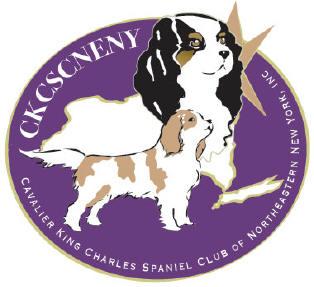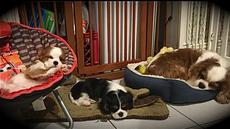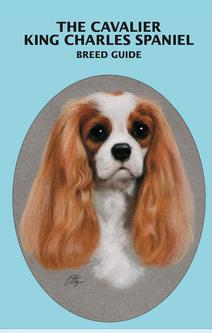Cavalier King Charles Spaniel Club
Of Northeastern New York
Cavalier King Charles Spaniel - Early History
Toy spaniels were a part of court life in Europe as early as the fifteenth century, sometimes referred to as “comforter spaniels” as they snuggled on their owner’s laps. They were immortalized in the art of Van Dyck, Titian, Stubbs, Landseer, and Gainsborough. But their association with the royal families of England has irrevocably linked their evolution to “that sceptred isle”. The unfortunate Mary Queen of Scots and Charles I, Charles II, and the Duke and Duchess of Marlborough-all helped to popularize this charming little dog. However, over the centuries the Cavalier was temporarily supplanted in public affection by the shorter muzzled, domed-headed King Charles Spaniel (a related but separate breed), and the Cavalier’s ultimate survival was in doubt.
In 1925, an American, Roswell Eldridge, became intrigued by the old Cavalier type as seen in many paintings and statues. He offered L25 at the UK Crufts Dog Show in 1926 for winners of Cavalier classes. This was a substantial amount in those times, and breeders accepted the challenge with alacrity. After considerable effort, the Cavalier was saved for posterity, and in 1928 the UK Cavalier King Charles Spaniel Club was founded. The first Cavaliers were sent to the USA in 1952. The breed has become increasingly popular, but it was not until 1996 that the Cavalier achieved full recognition by the AKC as the 140th AKC breed. The American Cavalier King Charles Spaniel Club was established in 1993 and remains the parent club for the Cavalier in this country.
Official Standard for the Cavalier King Charles Spaniel
BITE-A perfect, regular and complete scissors bite is preferred, i.e. the upper teeth closely overlapping the lower teeth and set square into the jaws. FAULTS-Undershot bite, weak or crooked teeth, crooked jaws
NECK-Fairly long, without throatiness, well enough muscled to form a slight arch at the crest. Set smoothly into nicely sloping shoulders to give an elegant look.
TOPLINE-Level both when moving and standing. BODY-Short-coupled with ribs well sprung but not barreled. Chest moderately deep, extending to elbows allowing ample heart room. Slightly less body at the flank than at the last rib, but with not tucked-up appearance. TAIL-Well set on, carried happily but never much above the back, and in constant characteristic motion when the dog is in action. Docking is optional. If docked, no more than one third to be removed.
FOREQUARTERS-Shoulders well laid back. Forelegs straight and well under the dog with elbows close to the sides. Pasterns strong and feet compact with well-cushioned pads. Dewclaws may be removed.
HINDQUARTERS-The hindquarters construction should come down from a good broad pelvis, moderately muscled; stifles well turned and hocks well let down. The hindlegs when viewed from the rear should parallel each other from hock to heel. FAULTS-Cow or sickle hocks.
COAT-Of moderate length, silky, free from curl. Slight wave permissible. Feathering on ears, chest, legs and tail should be long, and the feathering on the feet is a feature of the breed. No trimming of the dog is permitted. Specimens where the coat has been altered by trimming, clipping, or by artificial means shall be so severely penalized as to be effectively eliminated from competition. Hair growing between the pads on the underside of the feet may be trimmed.
COLOR-BLENHEIM-Rich chestnut markings well broken up on a clear, pearly white ground. The ears must be chestnut and the color evenly spaced on the head and surrounding both eyes, with a white blaze between the eyes and ears, in the center of which may be the lozenge or “Blenheim Spot”. The lozenge is a unique and desirable, though not essential, characteristic of the Blenheim. TRICOLOR-Jet black markings well broken up on a clear, pearly white ground. The ears must be black and the color evenly spaced on the head and surrounding both eyes, with a white blaze between the eyes. Rich tan markings over the eyes, on cheeks, inside ears and underside of tail. RUBY-Whole-colored rich red. BLACK AND TAN-Jet black with rich, bright tan markings over eyes, on cheeks, inside ears, on chest, legs and underside of tail. FAULTS-Heavy ticking on Blenheims or Tricolors; White marks on Rubies or Black and Tans.
GENERAL APPEARANCE-The Cavalier King Charles Spaniel is an active, graceful, well-balanced toy spaniel, very gay and free in action; fearless and sporting in character, yet at the same time gentle and affectionate. It is the typical gay temperament, combined with true elegance and royal appearance which are of paramount importance in the breed. Natural appearance with no trimming, sculpting or artificial alteration is essential to the breed type.
SIZE-Height 12 to 13 inches at the withers; weight proportionate to height, between 13 and 18 lbs. A small, well balanced dog within these weights is desirable, but these are ideal heights and weights and slight variations are permissible.
PROPORTION-The body approaches squareness, yet if measured from point of shoulder to point of buttock, is slightly longer than the height at the withers. The height from the withers to the elbow is approximately equal to the height from the elbow to the ground.
SUBSTANCE-Bone moderate in proportion to size. Weedy and coarse specimens are to be equally penalized.
HEAD-Proportionate to size of dog, appearing neither too large nor too small for the body.
EXPRESSION-The sweet, gentle, melting expression is an important breed characteristic.
EYES-Large, round, but not prominent and set well apart, color a warm, very dark brown; giving a lustrous, limpid look. Rims dark. There should be cushioning under the eyes which contributes to the soft expression. Faults-small, almond-shaped, prominent, or light eyes; which surrounding ring.
EARS-Set high, but not close, on top of head. Leather long with plenty of feathering and wide enough so that when the dog is alert, the ears fan slightly forward to frame the face.
SKULL-Slightly rounded, but without dome or peak; it should appear flat because of the high placement of the ears. Stop is moderate, neither filled nor deep.
MUZZLE-Full muzzle lightly tapered. Length from base of stop to tip of nose about 1-1/2 inches. Face well filled below eyes. Any tendency towards snippiness is undesirable. Nose pigment uniformly black without flesh marks and nostrils well developed. Lips well developed but not pendulous giving a clean finish. FAULTS-Sharp or Pointed muzzles.
GAIT-Free moving and elegant in action, with good reach in front and sound, driving rear action. When viewed from the side, the movement exhibits a good length of stride, and viewed from the front and rear it is straight and true, resulting from straight-boned fronts and properly made and muscled hindquarters.
TEMPERAMENT-Gay, friendly, non-aggressive with no tendency towards nervousness or shyness. Bad temper, shyness and meanness are not to be tolerated and are to be so severely penalized as to effectively remove the specimen from competition.
HEALTH ISSUES-Cavaliers, like all purebred dogs, have some hereditary conditions that can affect their health. It is important that you understand these health issues, especially as your pet ages. You are often your dog’s best line of defense against disease, because you’ll be the first to notice any changes to your dog’s behavior or sense of well being. Health conditions to be aware of in the Cavalier are: Mitral Valve Disease (MVD), Syringomyelia (SM), Juvenile Cataracts, Dry Eye, Glaucoma, Hip Dysplasia, Epilepsy, and Fly Catcher’s Syndrome.
OWNING A CAVALIER-The Cavalier must be a house pet and kept inside with the family. If this is not your lifestyle, please do not consider purchasing a Cavalier. He wants nothing so much as to be with the people he loves. Extremes of heat and cold are not well tolerated by Cavaliers and owners must be vigilant to keep them sheltered as they would their own human family.
Click on the Cavalier's face to review the
Breed Guide booklet



